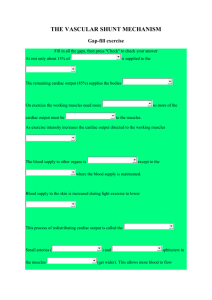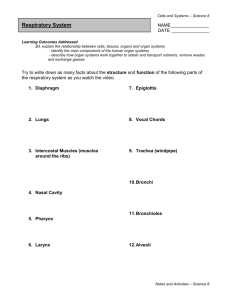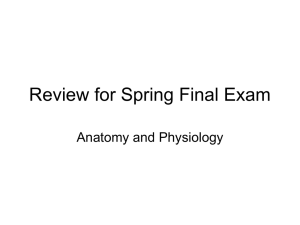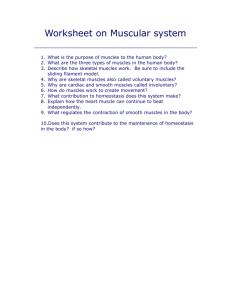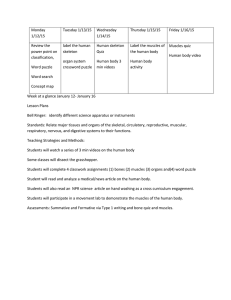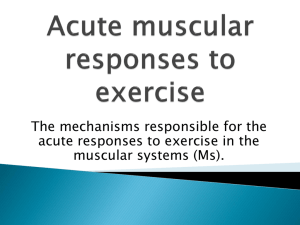Acute responses AOS1 O2
advertisement
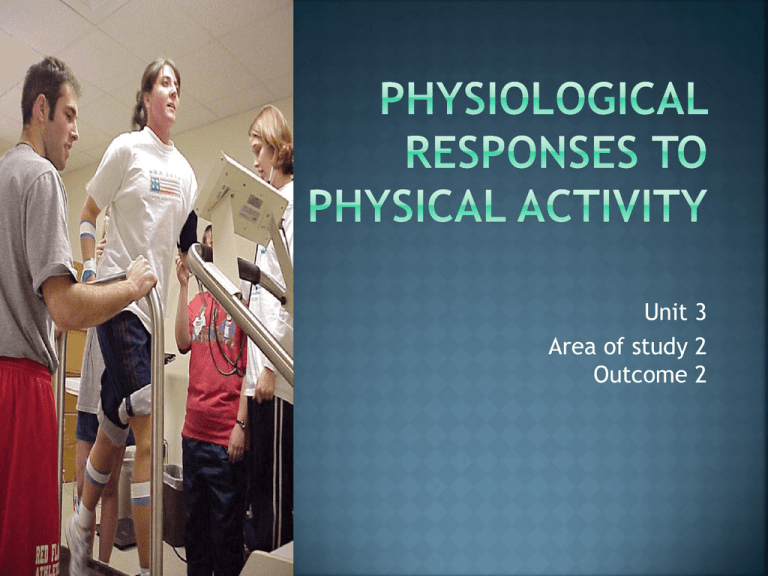
Unit 3 Area of study 2 Outcome 2 The mechanisms responsible for the acute responses to exercise in the cardiovascular, respiratory and muscular system. Words in red are to be defined in your glossary Physiological changes to accommodate energy requirements. There is an increased demand for O² and energy substrates, the Cardio-vascular, respiratory and muscular systems respond to meet these needs. Initial responses to exercise of the 3 systems are called ACUTE RESPONSES. The level of response is dependent on the intensity and type of exercise. When energy requirements are increased during the transition from rest to exercise the delivery of oxygen and fuels to the working muscles for ATP (Adenosine triphosphate) resynthesis is increased. Cardiovascular system: to transport and deliver oxygen to the skeletal muscles Respiratory Muscular system: to take in oxygen system: to uptake and utilise the available oxygen Acute responses to exercise are designed to facilitate an increase in the availability of oxygen and the removal of carbon dioxide. These include: Increased respiratory rate (breathing rate) Increased tidal volume Increased ventilation Increased oxygen uptake Copy Table 4.1 page 99 Define the above words using your textbook At rest, ventilation varies from person to person. Varies dependent on body size and gender from 4-15l Increases significantly during exercise from 15-30 times greater than at rest This increase in ventilation is a result of an increase in TV and/or RR V (L/min) = TV (l) X RR (breath/min) At a submaximal exercise intensity, ventilation increases rapidly at the start, then more slowly until it reached plateau. (at about 4-5min into exercise) During light to mod exercise, ventilation and oxygen consumption is linear Max intensity, ventilation increases until exercise stops At high intensities, TC plateaus and any further increase in ventilation is due to further increases in RR When ventilation is no longer increasing linearly with the increase in exercise intensity, this is called the ventilatory threshold. At the end of exercise and during recovery ventilation remains elevated for some time during recovery and returns to resting levels at a slow rate compared to the energy levels of the muscles which decrease immediately. Gas exchange occurs in the lungs at the alveolar-capillary interface and in the muscle at the tissue-capillary interface through DIFFUSION. Diffusion of gases always occurs from an area of high pressure to an area of low pressure. In the lungs: Oxygen concentration is high, so oxygen diffuses from the alveoli into the bloodstream Carbon dioxide levels in the blood are high so carbon dioxide moves from the blood into the alveoli via a diffusion path. 1. 2. Calculate the average person’s minute ventilation using an average Tidal Volume of 500mL and Respiratory Rate of 12 breathes per minute. Using your prior knowledge of the respiratory system, explain the mechanics of inspiration (inhalation) and expiration (exhalation), and how gases diffuse into and out of the lungs and blood vessels. (Use page 100 of your Nelson text book) Complete peak performance Warm-up 1b, 2, 6, Training – 1, 2, 3, Game on – 4, Table on Acute Respiratory Adaptations The CV system needs to deliver greater amounts of oxygen and energy substrates to the working muscles. Focus is to get more blood to the working muscles to meed this need and speed up the removal of carbon dioxide and waste products. Brain storm the acute responses of the cardiovascular system that take place when exercising. Increased heart rate Increased stroke volume Increased cardiac output Increased blood pressure Redistribution of blood flow to working muscles Increased arteriovenous difference DEFINE THE RED TERMS Copy Table 4.2 page 102 Nelson text book Heart rate: Is the number of times the heart contracts or beats per minute (bpm). When resting: heart rate usually 70 bpm During exercise: heart rate increases The increase in heart rate increases oxygen delivery to the working muscles and aids in the removal of waste products from the muscles and body. The greater the increase in intensity the greater the increase in heart rate Example: light or low intensity= 100-140 bpm Moderate intensity=140-160 High intensity=(maximum) point of exhaustion Calculated by subtracting the age of the individual from 220 (Maximum Calculate heart rate 220-age in years) your own heart rate Example: 220-17=203bpm Is the amount of blood ejected from the left ventricle with each beat (contraction) of the heart Answer the following Question in your work book: At what intensity of exercise does stroke volume reach maximum levels? Explain your answer. Cardiac output (Q): is the amount of blood ejected from the left ventricle of the heart per minute. (Already in glossary) It is the product of HR multiplied by SV Cardiac output (Q)= Heart rate (HR) x Stroke Volume (SV) So (Q) predictably increases during exercise Exam Question 2011 Question 9 Cardiac output is the combination of two factors. a. List the two factors. Do not use abbreviations in your answer. 2 marks b. Describe the relationship between cardiac output and oxygen uptake, and the role of the two factors listed in part a., when moving from resting state to exercising. 3 marks Exam Question 2010 Question 6 c. For a given cardiac output, an elite athlete 10kilometre runner will generally have a lower resting heart rate than an untrained person of the same age, weight and sex. c. Explain why this is the case by discussing the relationship between the cardiac parameters associated with this adaption. 3 marks Complete handout ‘ Acute cardiovascular responses to exercise’ Page 103 nelson text book Increased blood pressure: is the pressure exerted by the blood against the arterial walls as it is forced through the circulatory system by the action of the heart. Two components: Systolic blood pressure: is the blood pressure recorded as blood is ejected during the contraction phase of the heart cycle. It is the higher of the two blood-pressure values. Diastolic blood pressure: is the blood pressure recorded during the relaxation phase of the heart cycle. It is the lower of the two blood pressure values. Answer the following question in your work books: What is the normal blood pressure values at rest? Systolic blood pressure will increase when exercise intensity increases due to the increasing pressure on the artery walls. This may reach up to levels as high as 180-200 mm hg. Diastolic blood pressure changes little during exercise. If increased more than 10 mm hg this is considered abnormal. The minimal change is accounted for by the decrease in the peripheral resistance. During exercise venous return in increases by 3 mechanisms: the muscle pump, respiratory pump and vasoconstriction Activity: Summarise the 3 mechanism stated above pg 105 Question: What is the difference between Vasodilation and vasoconstriction? Explain how these processes result in the increased blood flow and oxygen delivery to working muscles During aerobic exercise, blood volume decreases Size of the decrease is dependent on the intensity of exercise, environmental factors such as temperature, and level of hydration of the individual Under resting condition there is only about 15-20 per cent of total blood flow that is directed to the skeletal muscles. The remaining 80-85 per cent is distributed to the other organs (heart, liver kidney, intestines and the brain) Under exercise this is reversed. Vasoconstriction in arterioles supplying inactive muscles, and vasodilation for active muscles. Rest 5000 ml Muscles, 20% other, 7% Brain, 14% Skin, 6% Heart, 4% Liver, 27% Kidneys, 22% other Brain Heart Kidneys Liver Skin Muscles Exercise Brain, 4% Other, 3% Kidneys , 1% Heart, 4% Liver, 2% Skin, 2% Muscles, 84% Other Brain Heart Kidneys Liver Skin Muscles • • • • Is a measure of the difference in concentration of oxygen in the arterial blood and the concentration of oxygen in the venous blood. measured in millilitres per 100 millilitres of blood. At rest arteries contain an oxygen consumption of 20 millilitres per 100 millilitres of blood (200 millilitres of oxygen per litre of blood At rest veins contain about 15 millilitres per 100 millilitres of blood. Arteriovenous oxygen difference at rest is about 5 millilitres per 100 millilitres of blood a-VO²diff= 20ml 100ml _ 15ml 100ml a-VO²diff= 5ml 100ml The amount of oxygen extracted from the arterial blood at rest is therefore about 25 percent. During exercise= working muscles use more oxygen from the blood that passes through. It is about 75 percent a-VO²diff increases and can be as high as 15-18 millilitres per 100 millilitres of blood Complete Changes the handout Acute Cardiovascular Warm-up – 1a, 3, 4, 5, 6, Training – 4, 5, 10, Game on – 3, 6. During exercise the amount of force developed by working muscle increases. This is done by the brain increasing the number of motor units recruited, or it can increase the frequency of messages sent to activate the motor unit. Define the following words: Adenosine triphosphate (ATP) Adenosine diphosphate (ADP) Phosphatecreatine (PC) Is the immediate source for all muscular contractions. Supply is relatively short When used up muscles must then relay on energy substrates to fuel metabolism. Glycogen is used in both anaerobic and aerobic respiration to produce ATP. During exercise PC donates a phosphate to ADP to resynthesise ATP. ATP, PC and muscle glycogen levels all decrease as does intramuscular triglyceride concentration. Glycogen decreases more rapidly with endurance activities compared to highintensity sprint activities. As exercise begins, and during maximal exercise, lactate is produced as a waste product from the creation of energy anaerobocally Therefore lactate levels in the muscles and the blood increase significantly. When oxygen supply equals oxygen demand, lactate does not accumulate. Lactate will continue to accumulate at intensities above the lactate inflection point (define pg 109). When ATP is metabolised (recreated using a fuel) in the muscle, heat is produced. With an increase in the rate of reactions, this results in an increase in heat which causes the body temperature to increase. The body accommodates this by sweating. Complete Acute Muscular responses to exercise Complete lab pg 112 Peak Performance Warm –up – 1c, 7, 8, 9, 10 Training – 6, 7, 8, 9, Game on – 1, 5, All multiple choice.
